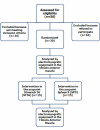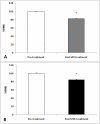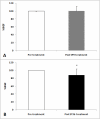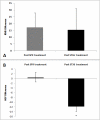The immediate effects of local and adjacent acupuncture on the tibialis anterior muscle: a human study
- PMID: 19094211
- PMCID: PMC2615752
- DOI: 10.1186/1749-8546-3-17
The immediate effects of local and adjacent acupuncture on the tibialis anterior muscle: a human study
Abstract
Background: This study compares the immediate effects of local and adjacent acupuncture on the tibialis anterior muscle and the amount of force generated or strength in Kilogram Force (KGF) evaluated by a surface electromyography.
Methods: The study consisted of a single blinded trial of 30 subjects assigned to two groups: local acupoint (ST36) and adjacent acupoint (SP9). Bipolar surface electrodes were placed on the tibialis anterior muscle, while a force transducer was attached to the foot of the subject and to the floor. An electromyograph (EMG) connected to a computer registered the KGF and root mean square (RMS) before and after acupuncture at maximum isometric contraction. The RMS values and surface electrodes were analyzed with Student's t-test.
Results: Thirty subjects were selected from a total of 56 volunteers according to specific inclusion and exclusion criteria and were assigned to one of the two groups for acupuncture. A significant decrease in the RMS values was observed in both ST36 (t = -3.80, P = 0,001) and SP9 (t = 6.24, P = 0.001) groups after acupuncture. There was a decrease in force in the ST36 group after acupuncture (t = -2.98, P = 0.006). The RMS values did not have a significant difference (t = 0.36, P = 0.71); however, there was a significant decrease in strength after acupuncture in the ST36 group compared to the SP9 group (t = 2.51, P = 0.01). No adverse events were found.
Conclusion: Acupuncture at the local acupoint ST36 or adjacent acupoints SP9 reduced the tibialis anterior electromyography muscle activity. However, acupuncture at SP9 did not decrease muscle strength while acupuncture at ST36 did.
Figures






Similar articles
-
Effects of acupuncture stimulation at different acupoints on formalin-induced pain in rats.Korean J Physiol Pharmacol. 2014 Apr;18(2):121-7. doi: 10.4196/kjpp.2014.18.2.121. Epub 2014 Apr 3. Korean J Physiol Pharmacol. 2014. PMID: 24757373 Free PMC article.
-
Electromyographic and strength analyses of activation patterns of the wrist flexor muscles after acupuncture.J Acupunct Meridian Stud. 2014 Oct;7(5):231-7. doi: 10.1016/j.jams.2014.02.005. Epub 2014 Mar 10. J Acupunct Meridian Stud. 2014. PMID: 25441947
-
Electromyographic evaluation of the masseter and temporal muscles activity in volunteers submitted to acupuncture.Electromyogr Clin Neurophysiol. 2007 Jul;47(4-5):243-50. Electromyogr Clin Neurophysiol. 2007. PMID: 17711042 Clinical Trial.
-
Comprehensive landscape-style investigation of the molecular mechanism of acupuncture at ST36 single acupoint on different systemic diseases.Heliyon. 2024 Feb 10;10(4):e26270. doi: 10.1016/j.heliyon.2024.e26270. eCollection 2024 Feb 29. Heliyon. 2024. PMID: 38375243 Free PMC article. Review.
-
Zusanli (ST36) Acupoint Injection for Diabetic Peripheral Neuropathy: A Systematic Review of Randomized Controlled Trials.J Altern Complement Med. 2018 Dec;24(12):1138-1149. doi: 10.1089/acm.2018.0053. Epub 2018 Sep 26. J Altern Complement Med. 2018. PMID: 30431314 Free PMC article.
Cited by
-
Electroacupuncture and Manual Acupuncture Increase Joint Flexibility but Reduce Muscle Strength.Healthcare (Basel). 2020 Oct 20;8(4):414. doi: 10.3390/healthcare8040414. Healthcare (Basel). 2020. PMID: 33092241 Free PMC article.
-
Immediate effects of acupuncture on biceps brachii muscle function in healthy and post-stroke subjects.Chin Med. 2012 Mar 14;7:7. doi: 10.1186/1749-8546-7-7. Chin Med. 2012. PMID: 22417176 Free PMC article.
-
Ipsilateral proprioceptive neuromuscular facilitation patterns improve overflow and reduce foot drop in patients with demyelinating polyneuropathy.J Exerc Rehabil. 2018 Jun 30;14(3):503-508. doi: 10.12965/jer.1836178.089. eCollection 2018 Jun. J Exerc Rehabil. 2018. PMID: 30018940 Free PMC article.
-
Applied kinesiology methods for a 10-year-old child with headaches, neck pain, asthma, and reading disabilities.J Chiropr Med. 2010 Sep;9(3):138-45. doi: 10.1016/j.jcm.2010.05.002. J Chiropr Med. 2010. PMID: 22027037 Free PMC article.
-
Investigation of electroacupuncture and manual acupuncture on carnitine and glutathione in muscle.Evid Based Complement Alternat Med. 2011;2011:297130. doi: 10.1093/ecam/nep071. Epub 2011 Jun 15. Evid Based Complement Alternat Med. 2011. PMID: 19592478 Free PMC article.
References
-
- Sousa RA, Semprini M, Vitti M, Borsato MC, Hallack Regalo SC. Electromyographic evaluation of the masseter and temporal muscles activity in volunteers submitted to acupuncture. Electromyogr Clin Neurophysiol. 2007;47:243–250. - PubMed
-
- Berman BM, Lao L, Langenberg P, Lee WL, Gilpin AMK, Hochberg MC. Effectiveness of acupuncture as adjunctive therapy in osteoarthritis of the knee. Ann Intern Med. 2004;141:901–910. - PubMed
LinkOut - more resources
Full Text Sources

